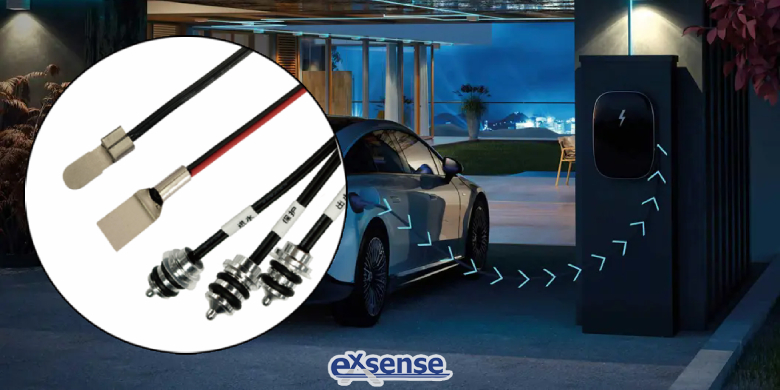NTC Temperature Sensor: "Neural Network" of Thermal Management in New Energy Vehicle

Amid the explosive growth of the new energy vehicle industry, thermal runaway in power batteries and motor overheating remain critical safety concerns. As the core component for temperature monitoring, NTC temperature sensors are quietly constructing a "temperature neural network" for NEVs, with an annual market growth rate of 23%(per MarketsandMarkets data).
First, Technical working principles and characteristics
The resistance value of NTC temperature sensor decreases exponentially with increasing temperature, resulting in a high detection accuracy of 0.05℃-0.5℃. Compared with traditional platinum resistors, its fast response time of 3-5 seconds is particularly outstanding in dynamic temperature monitoring scenarios.
In NEV applications, NTC temperature sensors demonstrate three key advantages:
1. Miniaturization: the size of internal NTC chip can reach 0.3mm×0.3mm
2. Wide operating temperature range: -50℃ to 150℃ covers all working conditions of the vehicle
3. Robustness: high protection level, resistant to high temperature and high humidity environment
Second, key applications and technological evolution
1. Power battery pack temperature monitoring
In battery packs of Tesla Model 3, 72 pcs NTC temperature sensors form a honeycomb matrix with 4680 cells, establishing a three-layer monitoring network:
- Surface NTC sensors monitor the efficiency of cooling efficiency
- Mid-layer NTC sensors track cell temperature
- Base layer NTC sensors detect temperature difference of coolant
Data transmitted via CAN bus to the BMS triggers balancing controls when temperature variance exceeds 5℃, reducing thermal runaway risks by 76% (CATL experimental data).
2. Overheat protection of motor drive system
NTC temperature sensor embedded in stator winding of permanent magnet synchronous motor, with ANSYS thermal simulation model to achieve:
- Dynamic temperature compensation control of winding
- Early warning of thermal aging of insulating materials
- Frequency conversion adjustment of the cooling system
BYD’s e-platform 3.0 uses an 8 pcs NTCs to extend motor peak power duration by 40%.
3. Intelligent thermal management systems
In heat pump HVAC systems, NTC temperature sensors from five control nodes:
|
Monitoring Point
|
Function
|
Accuracy Requirement
|
|
Ambient temperature outside the vehicle
|
Heat pump mode switching
|
±0.5℃
|
|
Battery coolant inlet
|
Refrigerant flow adjustment
|
±0.2℃
|
|
Cabin outlet
|
Zonal temperature control
|
±0.3℃
|
|
Compressor housing
|
Overheat protection
|
±1℃
|
|
Electronic expansion valve
|
Opening feedback control
|
±0.5℃
|
4. Charging Safety Protection
For DC fast charging, NTC temperature sensors provide triple-layer protection:
- EV Charger (monitoring temperature of terminal contact resistance value)
- Cable harnesses (detecting current overload heating)
- Battery interfaces (preventing arc faults)
NIO’s 500kW ultra-fast charger achieves 100ms thermal anomaly response via distributed NTC arrays.
Third, technical challenges and innovations
At present, the industry is facing three major technical bottlenecks:
1. Long-term drift in high temperatures (annual drift of about 0.3℃)
2. Signal distortion under EMI
3. Contact failure in complex vibration scenarios
Cutting-edge technology breakthrough direction:
- Material innovation: Graphene-doped composite ceramics improve linearity to ±0.5%
- Structural innovation: Triple-electrode structure designs enable self-diagnostics
- Integrated innovation: MEMS process Integrates NTC with Pressure Sensor, Reduces Cost by 30%
Fourth, future developed trends
1. Digital NTC popularization: Built-in ADC for I2C digital signal output
2. AI temperature prediction: LSTM algorithms for preemptive alerts
3. Wireless sensing networks: BLE 5.0 transmission technology to build passive monitoring nodes
Per Strategy Analytics, the NEV NTC market will exceed $1.8 billion by 2026, of which 60% of the demand comes from the temperature monitoring upgrade demand brought by the 800V high-voltage platform.
As NEVs evolve toward electrification, intelligence, and networking, NTC sensors are transforming from basic detectim elements into intelligent perception nodes, and continue to build a reliable thermal safety line of defense for the industry. EXSENSE Electronics Technology Co., Ltd. believes that the fast response to temperature of NTC temperature sensor will continue to help new energy vehicles accelerate in the future development path of it to adapt to the rapidly changing new energy market demand.



